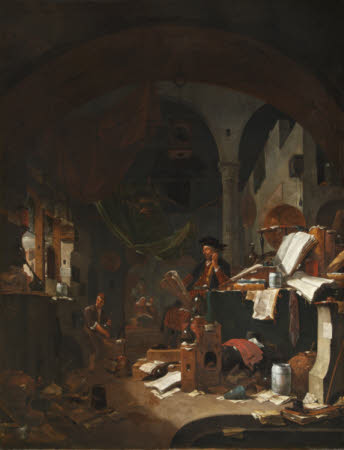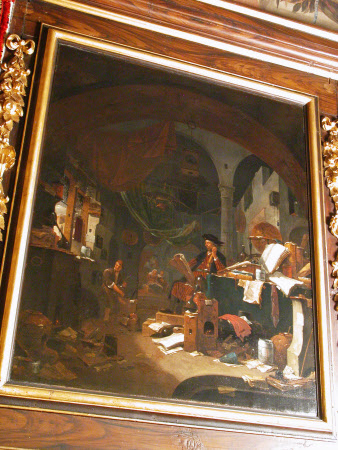An Alchemist
Thomas Wyck (Beverwijk 1616 - Haarlem 1677)
Category
Art / Oil paintings
Date
circa 1673
Materials
Oil on canvas
Measurements
1270 x 1016 mm (50 x 40 in)
Place of origin
England
Order this imageCollection
Ham House, Surrey
NT 1139739
Summary
Oil painting on canvas, An Alchemist by Thomas Wyck (Beverwijk 1616 – Haarlem 1677), signed: T. Wijk, circa 1673. A male figure in sixteenth century dress sitting upon a chair on a raised daiz in his workshop, which is cluttered with books and other objects. His male assistant stands to the left, carrying a large bottle. Other female figures can be seen through the door in the centre at the back. Wyck was born in Beverwijk near Haarlem where he principally worked. He came to England with his son, Jan, after the Restoration, and they are known to have been in London by the summer of 1674. They were among the most important Dutch painters working in England in the later Stuart period in the lesser genres, that is, those other than the portrait. Their works were often incorporated into the panelling of interiors; and the father and son worked for the Lauderdales at Ham. The Alchemist is presumably the painting that appears as no.46 in the 'Estimate' of pictures at Ham, 'A Chymist of Old Wyck' (MSS List at Ham House, undated, c.1679). It was one of the two pictures by Wyck that were put up in the Duke's closet and was probably the picture that the Duke's joiner fitted into the room later in 1674. The other, an Italianate landscape with ruins, had been installed slightly earlier when the joiner removed the panel over a door in the room in order to insert the picture. Thomas Wyck specialised in such subjects as alchemists in their laboratories, considered particularly suitable for libraries and studies like the Duke's closet, Italianate harbours, street scenes and landscapes, all painted in a decorative manner slightly reminiscent of Pieter Jacobsz Laar (Bamboccio). Good examples of his alchemists, presumably painted for English patrons, are at Knole and Hatfield. Wyck was back at Haarlem at the time of his death. (from Sir Oliver Millar in Treasure Houses of Britain, Five Hundred Years of Private Patronage and Art Collecting, New Haven/London, 1985)
Provenance
Painted for John Maitland, 1st Duke of Lauderdale and in 1677 inventory, thence by descent until acquired in 1948 by HM Government when Sir Lyonel, 4th Bt (1854 – 1952) and Sir Cecil Tollemache, 5th Bt (1886 – 1969) presented Ham House to the National Trust, and entrusted to the care of the Victoria & Albert Museum, until 1990, when returned to the care of the National Trust, and to which ownership was transferred in 2002
Credit line
Ham House, The Dysart Collection (purchased by HM Government in 1948 and transferred to the National Trust in 2002)
Makers and roles
Thomas Wyck (Beverwijk 1616 - Haarlem 1677), artist
Exhibition history
The Treasure Houses of Britain, National Gallery of Art, Washington, USA, 1985 - 1986, no.101
References
Croft-Murray 1962-1970: Edward Croft-Murray, Decorative Painting in England, 1537 - 1837 (2 vols), 1962-1970, vol.1, p.229


